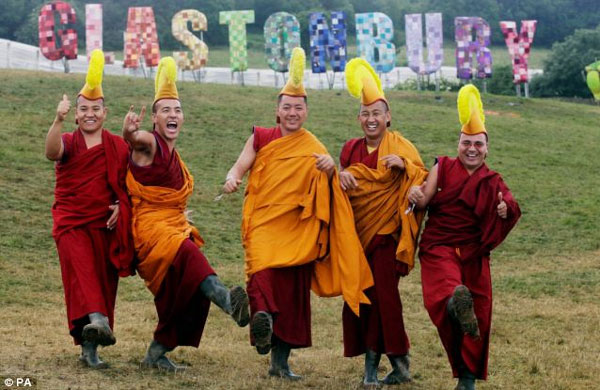The oldest rockers in town: No, not the Stones, but the monks who've been singing for 600 years

By Nicole Lampert
Published: September 2013
Daily Mail, UK
The Rolling Stones were a huge hit when they headlined Glastonbury this summer, but an even older group were the festival's surprise stars.
Sporting flowing red robes, shaved heads and serene smiles, the Gyuto Monks of Tibet stole the show as they chanted across the muddy fields of Somerset.
'We were deliriously happy,' says Lobsang Yeshi, the spiritual leader of the group. 'The closest thing we have to that is our initiation ceremony when thousands of people come but that was nothing compared to Glastonbury. The sheer size was immense; we were really gobsmacked.'
Their distinctive sound has been wooing audiences across the globe for four decades and has just secured the men a record deal with Decca. Now, producer Youth — who has worked with Primal Scream, Paul McCartney and The Verve — has given the group a modern twist, adding Tibetan singers and instruments to create the sort of ambient music you can imagine being played at trendy beachside bars.
Group translator Sonam, a former monk 'until I was discovered by girls', he jokes, says they are 'the world's oldest rock band'.
Their music comes from the abbot of a Tibetan monastery who, 600 years ago, saw a vision of Death. A strange noise came out of his chest and frightened Death away. They've been chanting like that ever since.
To my untrained ear it sounds a bit like a human didgeridoo. The monks chant three octaves in a single note at once which, they tell me, is almost impossible to do.
The area around their thorax is apparently more relaxed than it is for ordinary mortals because they lead selfless peaceful lives. The sound is certainly relaxing. But the monks believe that if you concentrate on the songs for exactly 12 seconds it can 'change your brain'.
'It goes straight to the joyful, cheerful brain neurons,' says lead chanter Jamyang. 'This music isn't just entertainment, but a physical instrument for change.' The first group of Gyuto monks to find fame came to London in 1973 for a sold-out show at the Royal Albert Hall.
They went on to have worldwide success, especially in Australia, and — bizarrely — toured America with the Grateful Dead.
This is their first trip back to Britain in 40 years, from their home in exile in India. Almost all of the present line up — which changes every year — were born in Tibet but escaped the repressive Chinese regime as teenagers and spent months trekking across the mountains to reach Dharamsala, a village in the mountains north of New Delhi and home to the Dalai Lama, and become monks. There, they rise at 5.30am for a day of prayer, contemplation, art and song but they seem to love life on the road.
They most enjoyed visiting Lord's cricket ground, where they recently blessed the turf.
Lobsang Jigme, the only group member to be born in India among the Tibetan refugees, seems the most excited about it.
'We like to play cricket outside the grounds of the monastery whenever we have a break,' he says.
'A Test match is a bit like seeking deep enlightenment; it represents what we are all about. To reach enlightenment we have six arts of compassion which are generosity, patience, endurance, wisdom, concentration and focus.
'A Test match is a game which requires all those virtues. The cricketers are just seeking their perfection in their own skills.
'We felt very privileged to be at Lord's. I actually didn't dare step on the sacred turf even though we were invited to — for me it felt like an ancient holy shrine.'
'We want to win the hearts and minds of people all over the world,' says Lobsang Yeshi.
'We also are a symbol of the Tibetans — exerting a gentle, soft kind of pressure, reminding people in the West about our status as refugees so that they can convince the Chinese to let us go home.'
For sheer satisfaction, even Sir Mick and his wrinkly bandmates would struggle to top that.
- The album Chants: The Spirit of Tibet is out now.